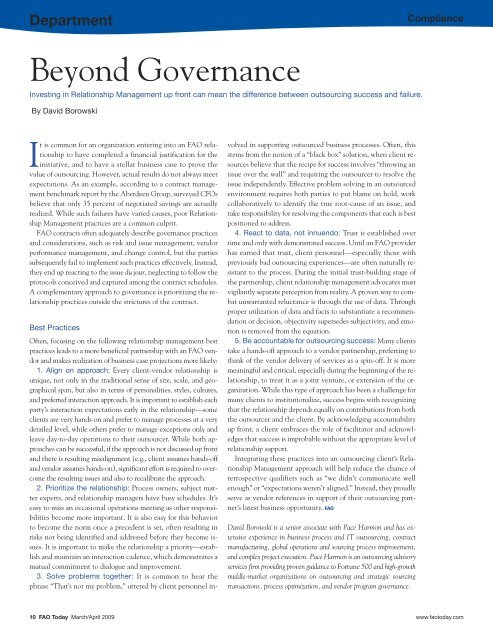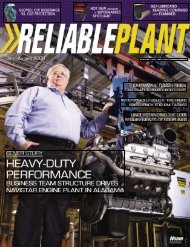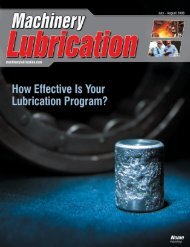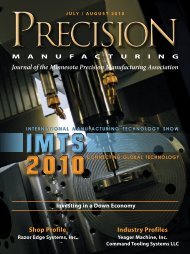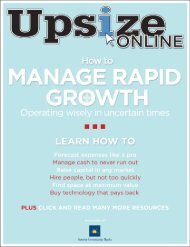March/April 2009 www.FAOToday.com
March/April 2009 www.FAOToday.com
March/April 2009 www.FAOToday.com
You also want an ePaper? Increase the reach of your titles
YUMPU automatically turns print PDFs into web optimized ePapers that Google loves.
Department<br />
Compliance<br />
Beyond Governance<br />
Investing in Relationship Management up front can mean the difference between outsourcing success and failure.<br />
By David Borowski<br />
It is <strong>com</strong>mon for an organization entering into an FAO relationship<br />
to have <strong>com</strong>pleted a financial justification for the<br />
initiative, and to have a stellar business case to prove the<br />
value of outsourcing. However, actual results do not always meet<br />
expectations. As an example, according to a contract management<br />
benchmark report by the Aberdeen Group, surveyed CFOs<br />
believe that only 35 percent of negotiated savings are actually<br />
realized. While such failures have varied causes, poor Relationship<br />
Management practices are a <strong>com</strong>mon culprit.<br />
FAO contracts often adequately describe governance practices<br />
and considerations, such as risk and issue management, vendor<br />
performance management, and change control, but the parties<br />
subsequently fail to implement such practices effectively. Instead,<br />
they end up reacting to the issue du jour, neglecting to follow the<br />
protocols conceived and captured among the contract schedules.<br />
A <strong>com</strong>plementary approach to governance is prioritizing the relationship<br />
practices outside the strictures of the contract.<br />
Best Practices<br />
Often, focusing on the following relationship management best<br />
practices leads to a more beneficial partnership with an FAO vendor<br />
and makes realization of business case projections more likely:<br />
1. Align on approach: Every client-vendor relationship is<br />
unique, not only in the traditional sense of size, scale, and geographical<br />
span, but also in terms of personalities, styles, cultures,<br />
and preferred interaction approach. It is important to establish each<br />
party’s interaction expectations early in the relationship—some<br />
clients are very hands-on and prefer to manage processes at a very<br />
detailed level, while others prefer to manage exceptions only and<br />
leave day-to-day operations to their outsourcer. While both approaches<br />
can be successful, if the approach is not discussed up front<br />
and there is resulting misalignment (e.g., client assumes hands-off<br />
and vendor assumes hands-on), significant effort is required to over<strong>com</strong>e<br />
the resulting issues and also to recalibrate the approach.<br />
2. Prioritize the relationship: Process owners, subject matter<br />
experts, and relationship managers have busy schedules. It’s<br />
easy to miss an occasional operations meeting as other responsibilities<br />
be<strong>com</strong>e more important. It is also easy for this behavior<br />
to be<strong>com</strong>e the norm once a precedent is set, often resulting in<br />
risks not being identified and addressed before they be<strong>com</strong>e issues.<br />
It is important to make the relationship a priority—establish<br />
and maintain an interaction cadence, which demonstrates a<br />
mutual <strong>com</strong>mitment to dialogue and improvement.<br />
3. Solve problems together: It is <strong>com</strong>mon to hear the<br />
phrase “That’s not my problem,” uttered by client personnel involved<br />
in supporting outsourced business processes. Often, this<br />
stems from the notion of a “black box” solution, when client resources<br />
believe that the recipe for success involves “throwing an<br />
issue over the wall” and requiring the outsourcer to resolve the<br />
issue independently. Effective problem solving in an outsourced<br />
environment requires both parties to put blame on hold, work<br />
collaboratively to identify the true root-cause of an issue, and<br />
take responsibility for resolving the <strong>com</strong>ponents that each is best<br />
positioned to address.<br />
4. React to data, not innuendo: Trust is established over<br />
time and only with demonstrated success. Until an FAO provider<br />
has earned that trust, client personnel—especially those with<br />
previously bad outsourcing experiences—are often naturally resistant<br />
to the process. During the initial trust-building stage of<br />
the partnership, client relationship management advocates must<br />
vigilantly separate perception from reality. A proven way to <strong>com</strong>bat<br />
unwarranted reluctance is through the use of data. Through<br />
proper utilization of data and facts to substantiate a re<strong>com</strong>mendation<br />
or decision, objectivity supersedes subjectivity, and emotion<br />
is removed from the equation.<br />
5. Be accountable for outsourcing success: Many clients<br />
take a hands-off approach to a vendor partnership, preferring to<br />
think of the vendor delivery of services as a spin-off. It is more<br />
meaningful and critical, especially during the beginning of the relationship,<br />
to treat it as a joint venture, or extension of the organization.<br />
While this type of approach has been a challenge for<br />
many clients to institutionalize, success begins with recognizing<br />
that the relationship depends equally on contributions from both<br />
the outsourcer and the client. By acknowledging accountability<br />
up front, a client embraces the role of facilitator and acknowledges<br />
that success is improbable without the appropriate level of<br />
relationship support.<br />
Integrating these practices into an outsourcing client’s Relationship<br />
Management approach will help reduce the chance of<br />
retrospective qualifiers such as “we didn’t <strong>com</strong>municate well<br />
enough” or “expectations weren’t aligned.” Instead, they proudly<br />
serve as vendor references in support of their outsourcing partner’s<br />
latest business opportunity. FAO<br />
David Borowski is a senior associate with Pace Harmon and has extensive<br />
experience in business process and IT outsourcing, contract<br />
manufacturing, global operations and sourcing process improvement,<br />
and <strong>com</strong>plex project execution. Pace Harmon is an outsourcing advisory<br />
services firm providing proven guidance to Fortune 500 and high-growth<br />
middle-market organizations on outsourcing and strategic sourcing<br />
transactions, process optimization, and vendor program governance.<br />
10 FAO Today <strong>March</strong>/<strong>April</strong> <strong>2009</strong> <strong>www</strong>.faotoday.<strong>com</strong>


